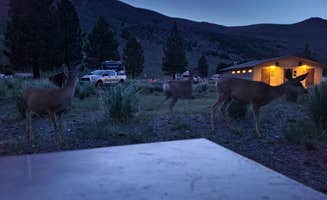Equestrian camping near Bass Lake, California provides access to mountain trails at elevations ranging from 3,400 to 7,200 feet. The Sierra National Forest surrounds this area, offering terrain that transitions from pine forests to high-country meadows. Summer temperatures average 75-85°F during daytime with cooler evenings dropping to 45-55°F, while winter access becomes limited above 5,000 feet due to snowfall.
What to do
Trail riding from Goat Meadow: Located approximately 5 miles from the south entrance of Yosemite, this dispersed camping area serves as an excellent base for equestrian day trips. "Beautiful scenery, clean, close to Yosemite, and easy to reach. As others have said, follow Mount Raymond Rd up until you see the sign for the snow play area, and look to the right," notes Derrick H.
Explore high-elevation routes: Bridalveil Creek Campground offers access to mountain trails between 6,500-8,000 feet. "Just off the road that takes you to Glacier Point. Reservations not needed, but tough to get on weekends," advises Buck R., who recommends timing your visit carefully.
Creek access for horses: The nearby Big Sandy Campground features creek access suitable for watering horses after trail rides. "Has a very nice stream that runs right down the middle of campground that basically every site is next to the water," shares Leon G., highlighting a practical feature for equestrians.
What campers like
Elevation and cooler temperatures: Horse riders appreciate the higher elevation campsites during summer months when valley temperatures soar. "The elevation at the site is appx 5200, meaning it will get snow in the winter(ish) months," explains Alexander Mark C. about Goat Meadow, noting how elevation affects seasonal camping conditions.
Proximity to multiple trail systems: North Pines Campground offers connections to both valley floor and climbing trails. "This campground is in the heart of Yosemite Valley. It is great to camp on the valley floor, especially during peak season as traffic from all main gates to the valley floor is very congested," reports Kerry V., highlighting the accessibility.
Larger sites for horse trailers: Several campgrounds accommodate horse trailers with ample parking areas. "Quite a large level area, though it was November and not peak season so there were loads of space. We pulled in and there were a couple of trailers with horses," observes Kevin T. about dispersed camping options in the area.
What you should know
Seasonal closures affect horse trails: Many high-country horse trails become inaccessible after first snowfall. "This area is a portion of the area which in recent years experienced forest fires so there are lots of downed limbs in the area," notes Crystal C. at Sweetwater Campground, which serves as a lower-elevation alternative when higher trails close.
Limited water sources: Not all equestrian campsites provide reliable horse water. "No water unless you use the creek. Please report any trash or other issues to the Prather Ranger Station," advises Collin about Sample Meadow Campground, emphasizing the need to plan for water access.
Road conditions affect trailer access: Forest service roads leading to horse camps vary significantly in quality. "The 6 mile road to get into it is rough. With high rain season, you have to cross the creek and it may require a lifted type vehicle like a truck," warns Rosina A. about accessing certain camping areas with horse trailers.
Tips for camping with families
Choose camps with creek access: Children enjoy water features while horses rest. "Beautiful area surrounded by trees so lots of shade. Came on 4th of July so the crowd is a lil rowdy but I found a spot farther away which is nice!" shares Taryn R. about Goat Meadow, noting how site selection affects experience.
Plan for temperature variations: Sierra elevations experience significant day-night temperature swings. "It also gets extremely cold at night so make sure to bring warm clothes and have a good tent and sleeping bag," advises Darlene M. about Sample Meadow Campground, particularly important when camping with children.
Wildlife awareness for children: Yosemite Valley Backpacker's Campground and surrounding areas require proper food storage. "Coyotes and bears are active in the area—coyotes raided a bag I had hanging from a tree and stole my food!" reports Alexander Mark C., emphasizing the importance of teaching children proper wilderness practices.
Tips from RVers
Length limitations on mountain roads: RVers with horse trailers should research road conditions carefully. "The roads nearby can take you to Kaiser Wilderness and Kaiser Peak. By car it's only assessable between June and October," shares Darlene M. about forest service roads, which often impose length restrictions.
Parking configurations at horse camps: COE Eastman Lake Codorniz Campground offers organized parking suitable for truck-trailer combinations. "Sites are asphalt. Many sites may take some time to level. Back in and pull through are available," notes Tom D., providing practical information for RVers with horse trailers.
Generator restrictions near horse areas: Most horse-friendly campgrounds limit generator hours to prevent spooking animals. "We are not RV people so we don't know why they need to run them. Next time we will camp in a tent only area," comments Sarah F., highlighting potential conflicts between different camping styles.



